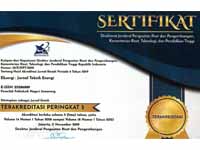Design And Simulation Of Solar Power Generation On Rooftops Towards Clean Technology
DOI:
https://doi.org/10.32497/eksergi.v19i2.4467Keywords:
Clean energy, solar energy, building rooftops, solar power generationAbstract
Various efforts are continuously being encouraged and pursued in order to achieve the clean energy transition program. The clear goal is to reach a renewable energy mix target of 23% by 2025. The use of electrical energy is increasing each year, but the availability of fossil energy as the majority fuel used in power generation is becoming limited. Indonesia, being located near the equator, experiences high solar radiation intensity. This potential can be utilized for harnessing solar energy as a power source. Additionally, the utilization of solar energy as an alternative source is more environmentally friendly as it reduces emissions from fossil fuel-based power generation. In this research, the design and planning of a solar power plant are conducted to create clean and environmentally friendly energy. The technical aspects are discussed and simulated using software. The author utilizes the Helioscope application for analyzing the feasibility of installing a solar power plant and conducting simulations. Based on the research results, by utilizing a roof area of 13,725 m2 and installing 2,305 solar modules with a capacity of 550 Wp per module, the solar power plant's capacity amounts to 1,267.8 kWp. The performance ratio is calculated to be 80.6%, and the energy production over a year is estimated at 1,695,000 MW.References
Ariyani, S., Wicaksono, D. A., Fitriana, F., Taufik, R., & Germenio, G. (2021). Study of Solar Power Plant Planning and Monitoring Systems in Remote Areas. Techné: Scientific Journal of Electrotechnical Engineering, 20(2), 113”“124. https://doi.org/10.31358/techne.v20i2.273
Brahma, I. G. C., Kumara, I. N. S., Ayu, I., Giriantari, D., & Raya. (2021). Design and Simulation of a 1 KWp Roof PLTS Using a Helioscope. 8(2), 249”“256.
Damara, D., Fitria, K. S., & Anggreini, R. (2021). Room for a reduction in prime lending rates is still wide. Indonesian Business. https://bisnisindonesia.id/
Folsom Labs. (2021). Understanding DC/AC Ratio. Helio Scope Help Docs, Dc, 1”“3.
Ministry of Energy and Mineral Resources (KESDM). (2018). Permen of ESDM Number 13 of 2019 Amendment Number 49 of 2018.
Pramudita, B. A., Aprillia, B. S., & Ramdhani, M. (2021). Economic Analysis on Grid PLTS for 2200 VA Homes. Journal of Electrical, Instrumentation and Applied Electronics (JuLIET), 1(2), 23”“27. https://doi.org/10.22146/juliet.v1i2.61879
Karuniawan, E. A. (2021). PVSYST, PVSOL and HelioScope Software Analysis in Fixed Tilt Photovoltaic Simulation. Journal of Electrical Technology, 12(3), 100. https://doi.org/10.22441/jte.2021.v12i3.001
Ministry of Energy and Mineral Resources. (n.d.). PLTS Operation and Maintenance Guide.
Mohammad Hafidz;, S. S. (2015). Design and Analysis of a 10 MW On Grid Solar Power Plant in Yogyakarta. Electrical Engineering Department, Pln Engineering College, 7 (Energy & Electrical Journal Vol. 7 No. 1, January-May 2015), 49.
Ngurah, I. G., & Dwijaya, A. (2019). Textbook Draft (September Issue).
Pudin, A., & Mardiyanto, I. R. (2020). Design and Implementation of Data Logger for Measurement of Solar Panel Output Power and Solar Irradiation. ELKOMIKA: Journal of Electrical Energy Engineering, Telecommunications Engineering, & Electronics Engineering, 8(2), 240. https://doi.org/10.26760/elkomika.v8i2.240
Putri, I. H. K. (2020). Analysis of the Work and Maintenance System of the On Grid Solar Power Plant (PLTS) with a capacity of 4.2 kWp in the Magnolia 1 housing complex, South Tangerang.
Rachmi, A., Prakoso, B., Hanny Berchmans, Devi Sara, I., & Winne. (2020). Planning and Utilization Guide for Rooftop PLTS in Indonesia. PLTS Roof, 94.
Rif'an, M., Sholeh, Shidiq, M., Yuwono, R., Suyono, H., & Fitriana. (2012). Optimization of Utilization of Solar Electric Energy. EECCIS Journal, 6(1), 44”“48.
Romadhoni, M., E, E., & S, A. (2020). Solar Electricity on Grid on the Roof of the Regional Inspectorate Building, Samarinda City, East Kalimantan. STT PLN librarian. http://156.67.221.169/id/eprint/2869
Samsurizal, S., Afrianda, R., & Makkulau, A. (2022). Optimizing the Potential of Solar Energy PT PJB UP Muara Karang Rooftop Area Using HelioScope. Elkha, 14(1), 1. https://doi.org/10.26418/elkha.v14i1.49910
Sapan, M.L. (2019). Design of a Solar Power Generation System for Block Ice Production with a Capacity of 2 Tons Per Day. Knowledge And Attitudes In Health Research, 11150331000034, 1”“147.
Sianipar, R. (2014). Basic Planning of Solar Power Plants. 11(2), 61”“78.
Syihan, N. (2020). Planning for On Grid Solar Power Plant on the Roof of Pt Indo Mahakarya Gemilang Office.
Windarta, J., Wista Sinuraya, E., Zaenal Abidin, A., Era Setyawan, A., & Angghika. (2019). Design of a Homer-Based Solar Power Plant (PLTS) at SMA Negeri 6 Surakarta as an Energy-Saving and Environmentally Friendly School. Proceedings of the 2019 MIPA National Seminar, Tidar University, 21”“36.
Downloads
Published
Issue
Section
License
Authors who publish with this journal agree to the following terms:Authors retain copyright and grant the journal right of first publication with the work simultaneously licensed under a Creative Commons Attribution License that allows others to share the work with an acknowledgement of the work's authorship and initial publication in this journal.
Authors are able to enter into separate, additional contractual arrangements for the non-exclusive distribution of the journal's published version of the work (e.g., post it to an institutional repository or publish it in a book), with an acknowledgement of its initial publication in this journal.
Authors are permitted and encouraged to post their work online (e.g., in institutional repositories or on their website) prior to and during the submission process, as it can lead to productive exchanges, as well as earlier and greater citation of published work (See The Effect of Open Access).






